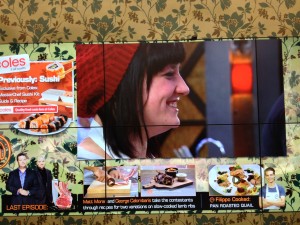Cisco Unveils their Vision of Second Screen 2.0
By Phil Lelyveld
In a room at the back of the Cisco NAB booth (North Hall booth A113), and in a few session presentations by UK VP of Technology Simon Parnall, Cisco is showing its vision of the next generation of in-home audiovisual experiences. They have prototyped a system that allows browsers to work among multiple tiled screens, seamlessly joined in any configuration, and built into walls in the home. The screens are controlled by and can pass data back and forth from tablets, smartphones, and laptops. There is a counterpart sound system that balances the sound to the area on the wall where the corresponding video is being displayed.
The 4 components of their A/V vision are
- Seamless; the screens join with no visible bezel. The bezel on LCDs is very small now. R&D on next generation OLED displays may allow for seamless tiling in the foreseeable future. (Advances in OLED technology was discussed at an NAB Supersession on Display Technologies of the Future by Gary Mandle of Sony Electronics)
- Unobtrusive; portions of the screens that are not displaying a video image take on the appearance of the surrounding walls. In the demo suite they blend with the wallpaper color and pattern.
- Ultra high def; because the image can be enlarged to fill an entire wall, the system is designed to accommodate ultra high resolution, and
- Ambient; the information is controlled by you, adapts to you, and can be tailored to your tastes, geolocation, and other hyperpersonalization factors.
The demonstration installation manipulates audiovisual feeds from broadcast, broadband, and “domotic” sources (e.g. home-generated data like temperature controls, baby cams, and photo albums).
This browser-based solution is similar to other systems that allow the user to move and manipulate data among multiple screens and to and from tablets and smart phones, such as Oblong Industries (http://oblong.com/client-solutions/ ) business solution (they did the ‘Minority Report’ visualization) and Apple and Microsoft apps.
What makes the Cisco prototype interesting at this time is the context in which is it being shown.
First, it is not far from NHK’s demonstration of 8K video capture and display. NHK's 20 minute theatrical demo clearly showed the value of an occasional 8K viewing experience. Cisco’s approach of feeding an 8K signal to a seamless tiled 8K-equivalent screen that has other uses when not displaying 8K content could put 8K experiences in consumers’ homes much faster, and sell more displays, as a complementary strategy to selling single-piece large 8K displays.
Second, the large amount of video real estate available through this approach could greatly expand the use of, and monetization opportunities of, 2nd screen applications. It allows for multiple sidebars on the wall, and a new interplay between large displays and tablets. If one person in the room wants to do a 2nd screen activity, they can do it on their tablet. If others in the room want to interact, their tablets are all networked and can interact with the same app on the wall display. Cisco included a ‘couch cam’, so you could ‘look to your side’ and interact with your friends as they watch a program along with you at other locations.
Cisco showed an infrastructure that others companies - hardware, content, and applications developers – can build to. It is a unified vision of how information and entertainment, personal activities and public resources, can be integrated. It isn’t a new vision, but perhaps technology has advanced and prices have come down to the point where it can finally be realized.
Pages
- About Philip Lelyveld
- Mark and Addie Lelyveld Biographies
- Presentations and articles
- Tufts Alumni Bio
